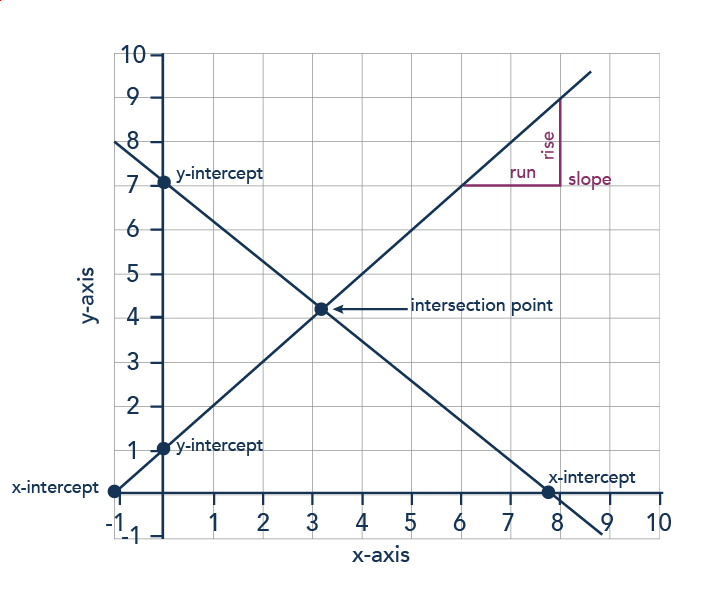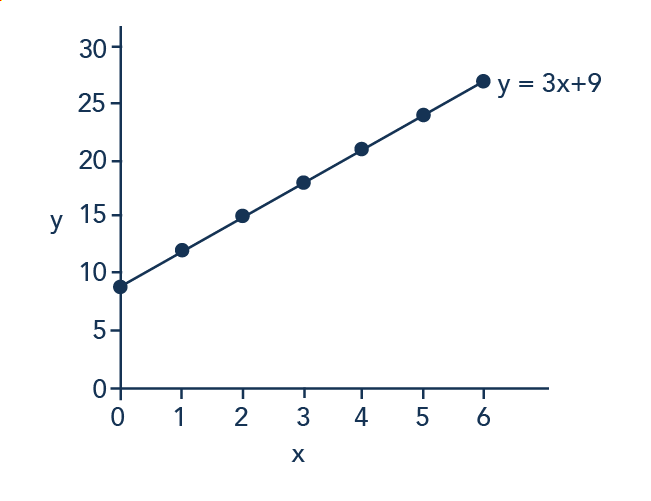Learning Objectives
- Explain how to construct a simple graph that shows the relationship between two variables
It’s important to know the terminology of graphs in order to understand and manipulate them. Let’s begin with a visual representation of the terms (shown in Figure 1), and then we can discuss each one in greater detail.

Figure 1. Graph Terminology.
Throughout this course we will refer to the horizontal line at the base of the graph as the x-axis. We will refer to the vertical line on the left hand side of the graph as the y-axis. This is the standard convention for graphs. In economics, we commonly use graphs with price (p) represented on the y-axis, and quantity (q) represented on the x-axis.
An intercept is where a line on a graph crosses (“intercepts”) the x-axis or the y-axis. Mathematically, the x-intercept is the value of x when y = 0. Similarly, the y-intercept is the value of y when x = 0. You can see the x-intercepts and y-intercepts on the graph above.
The point where two lines on a graph cross is called an intersection point.
The other important term to know is slope. The slope tells us how steep a line on a graph is as we move from one point on the line to another point on the line. Technically, slope is the change in the vertical axis divided by the change in the horizontal axis. The formula for calculating the slope is often referred to as the “rise over the run”—again, the change in the distance on the y-axis (rise) divided by the change in the x-axis (run).
Let’s use the same equation we used earlier, in the section on solving algebraic equations, y = 9 + 3x, which can also be written as:
Next we can place each of these points on a graph. We can start with 0 on the x-axis and plot a point at 9 on the y-axis. We can do the same with the other pairs of values and draw a line through all the points, as on the graph in Figure 2, below.
Watch It
Watch this video to take a closer look at graphs and how variables can be represented in graph form. NOTE: Around the two-minute mark, the narrator inadvertently says “indirect,” rather than “inverse.” This is corrected later in the video.
An interactive or media element has been excluded from this version of the text. You can view it online here: http://pb.libretexts.org/mlum/?p=70
Glossary
[glossary-page][glossary-term]intercept: [/glossary-term]
[glossary-definition]the point on a graph where a line crosses the vertical axis or horizontal axis [/glossary-definition][glossary-term]slope: [/glossary-term][glossary-definition]the change in the vertical axis divided by the change in the horizontal axis [/glossary-definition][glossary-term]variable: [/glossary-term][glossary-definition]a quantity that can assume a range of values [/glossary-definition][glossary-term]x-axis: [/glossary-term][glossary-definition]the horizontal line on a graph, commonly represents quantity (q) on graphs in economics [/glossary-definition][glossary-term]y-axis: [/glossary-term][glossary-definition]the vertical line on a graph, commonly represents price (p) on graphs in economics [/glossary-definition][/glossary-page]



